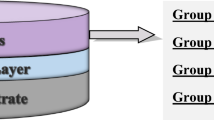Abstract
Chemical deposition from vapors of metalorganic compounds and volatile hydrides (metalorganic vapor phase epitaxy) is the main way of growing devices’ heteroepitaxial structures based on gallium arsenide (GaAs) and solid solutions of it (AlxGa1 – xAs and InyGa1 – yAs) on an industrial scale. Electrically active impurities deposited uncontrollably on epitaxial layers during growth worsen the electrophysical parameters of devices’ structures. Sources of deposited background impurities include the initial material. In this work, ways of synthesizing trimethylgallium (TMG) are compared from the viewpoint of impurities, especially electrically active GaAs, being incorporated into the final product. Ways of preparing TMG that include the exchange reaction between gallium trichloride and trimethylaluminum (TMA) and magnesium–organic syntheses in which metallic magnesium is used as the initial reagent are selected as the objects of study. The behavior of electrically active impurities during the purification of TMG via rectification is studied. The investigations are performed by means of spectral analysis and functional control over the growth of electrophysical parameters of GaAs epitaxial layers from TMG and arsine. It is established that the qualitative and quantitative composition of impurities in TMG depends on their content in the initial reagents. TMG prepared using the exchange reaction between gallium trichloride and TMA is the source of n-type impurities in GaAs. These are mainly Group IV elements (silicon, tin, and lead), with silicon impurities predominating. TMG fabricated using metallic magnesium is a source of both p- (preferentially zinc) and n-type (preferentially silicon) impurities. Irrespective of the quality of the initial raw TMG, the use of reduced-pressure rectification allows the fabrication of TMG with low impurity contents. Epitaxial GaAs layers grown using purified TMG (TMG rectificate) have n-type conduction with a low level of background doping (0.7–4) × 1014 cm–3 and high carrier mobilities of 7300–8500 cm2/(V s) at 300 K and 90 000–156 000 cm2/(V s) at 77 K. These values correspond to purest samples made with TMG and arsine using MOC-hydride epitaxy. Based on the data on functional control, the content of impurities that display electrical activity in GaAs is on the level of 10−7–10−6 at % in fabricated TMG-rectificate samples.
Similar content being viewed by others
REFERENCES
S. Adachi, GaAs and Related Materials: Bulk Semiconducting and Superlattice Properties (World Scientific, Singapore, 1994).
Zh. I. Alferov, Semiconductors 32, 1 (1998).
A. L. Aseev, Ross. Nanotekhnol., No. 1, 97 (2006).
G. B. Stringfellow, Organometallic Vapor Phase Epitaxy: Theory and Practice (Elsevier, Amsterdam, 1999), p. 35.
M. C. Hanna and Z. H. Lu, J. Cryst. Growth 124, 443 (1992).
D. L. Rode, Semiconductors and Semimetals, Ed. by R. K. Willardson and A. C. Beer (Academic, New York, 1975), Vol. 10.
A. S. Jones and P. O’Brien, CVD of Compound Semiconductors: Precursor Synthesis, Development and Applications (Wiley, Weinheim, New York, Basel, Cambridge, Tokyo, 1997).
K. B. Starowieyski, A. Chwojnowski, K. Jankowski, et al., Appl. Organomet. Chem. 16, 616 (2000).
V. I. Bregadze, L. M. Golubinskaya, and B. L. Kozyrkin, J. Clust. Sci. 13, 631 (2002).
M. V. Revin, A. N. Artemov, and E. V. Sazonova, Russ. J. Appl. Chem. 86, 1359 (2013).
A. N. Nesmeyanov and S. T. Ioffe, Methods of Element-Organic Chemistry (Akad. Nauk SSSR, Moscow, 1963) [in Russian].
Author information
Authors and Affiliations
Corresponding author
Additional information
Translated by N. Korovin
Rights and permissions
About this article
Cite this article
Revin, M.V., Kotkov, A.P., Ivanov, V.A. et al. Studying the Effect of Electrically Active Impurities Coming from Trimethylgallium Synthesized by Different Means on the Electrophysical Characteristics of Gallium Arsenide Epitaxial Layers. Semiconductors 52, 1947–1952 (2018). https://doi.org/10.1134/S1063782618150113
Received:
Accepted:
Published:
Issue Date:
DOI: https://doi.org/10.1134/S1063782618150113




